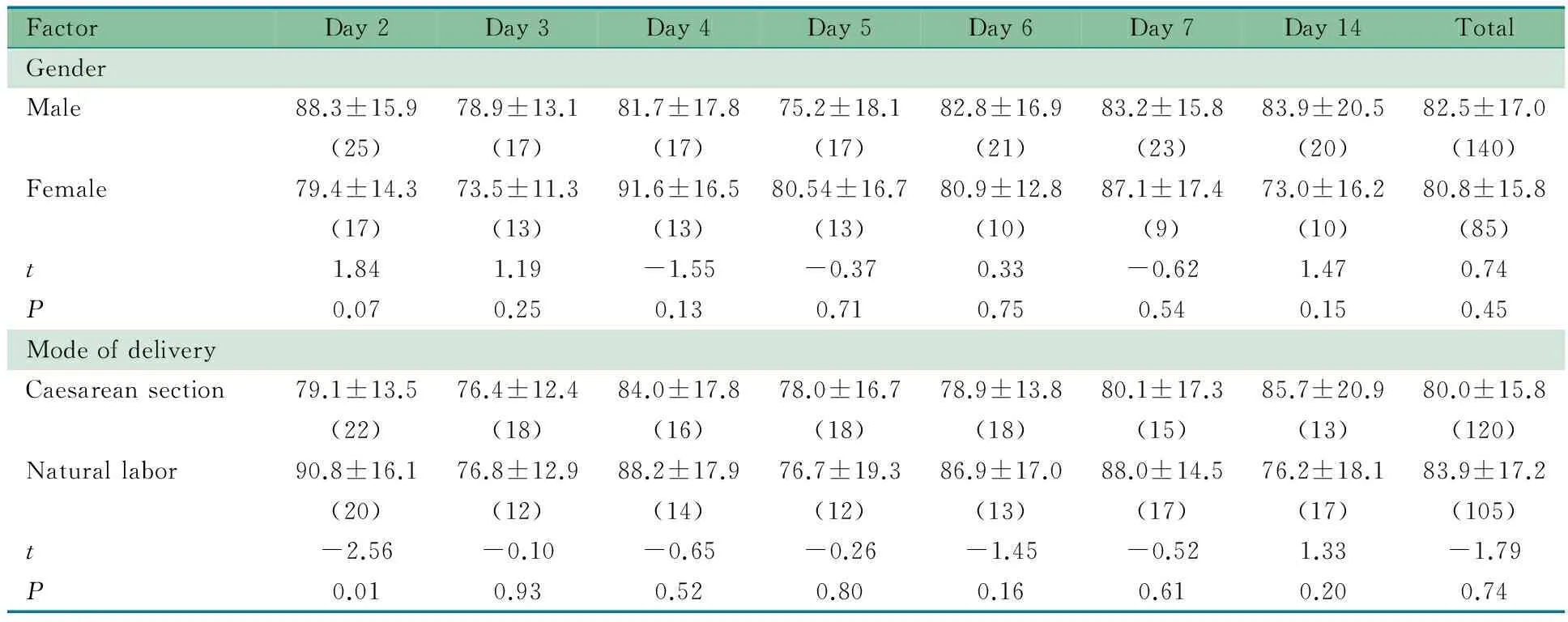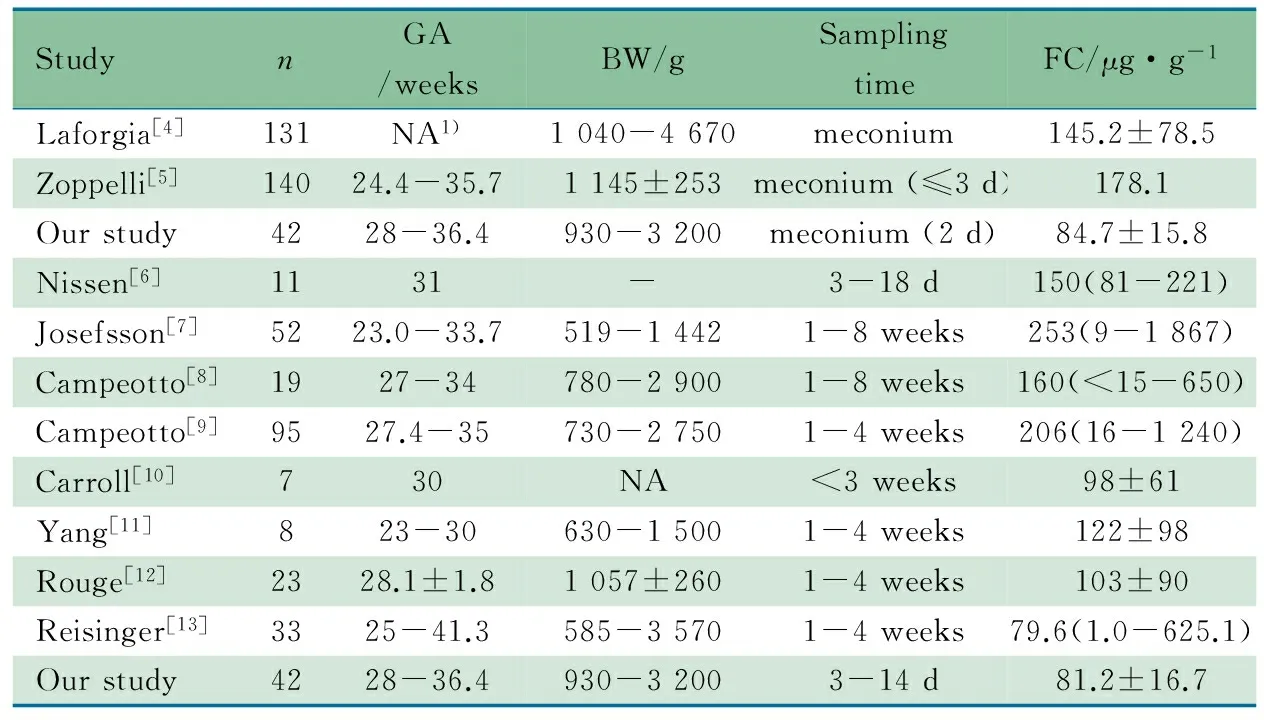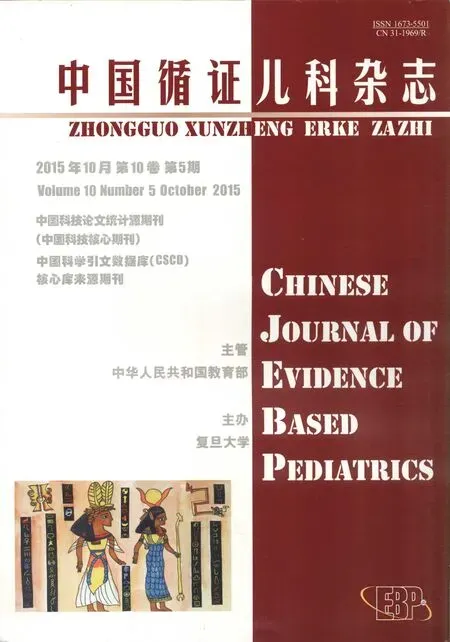早产儿生后2周粪钙卫蛋白动态变化及其影响因素
赵益伟 管亚飞 崔曙东 章 晔 邵晓松
早产儿生后2周粪钙卫蛋白动态变化及其影响因素
赵益伟1管亚飞2崔曙东2章 晔2邵晓松2
目的 了解早产儿生后2周粪钙卫蛋白(FC)水平及其影响因素。方法 纳入2011年3~6月南京大学第一附属医院及温州医科大学附属乐清医院新生儿科住院的早产儿病例,排除严重的胃肠和全身疾病者。采集早产儿生后2、3、4、5、6、7和14 d的7个日龄粪便标本,采用ELISA法测定FC水平。结果 42例早产儿进入分析,其中男25例,女17例,中位胎龄34.5(28~36.4)周,中位出生体重2 200(930~3 200)g。①胎粪(生后2 d)FC水平为(84.7±15.8) μg·g-1,3~7、14 d FC水平分别为(76.5±12.4)、(86.0±17.6)、(77.5±17.4)、(82.2±15.5)、(84.3±16.1)和(80.3±19.6)μg·g-1;7个日龄FC水平总体差异无统计学意义。②胎粪FC水平剖宫产儿显著低于自然分娩儿,差异有统计学意义(t=-2.56,P=0.01),生后2周内不同日龄FC水平与性别、孕龄及出生体重无显著相关性;生后3~14日龄FC水平还与分娩方式无显著相关性。结论 生后2周早产儿不同日龄FC水平相近,分娩方式对胎粪FC水平有影响。
早产儿; 粪钙卫蛋白; 影响因素
新生儿坏死性小肠结肠炎(NEC)为早产儿常见的危重症,其诊断主要依靠临床表现及腹部X线征象,但当临床表现及X线表现明显时,病情常已极危重,目前尚无特异性的诊断指标可早期诊断NEC。钙卫蛋白为一种非糖基化蛋白,分子量36.5 kD,存在于中性粒细胞、单核细胞及巨噬细胞中,占中性粒细胞细胞质蛋白的60%。成人炎症性肠病(IBD)、肠道感染时,中性粒细胞跨膜迁移入肠腔,粪钙卫蛋白(FC)水平升高,FC已作为IBD诊断及活动度指标[1]。由此推测,FC亦可能是评价新生儿肠道状态的标志物。近年来,国外已陆续有足月儿及早产儿FC的报道,有文献提示FC对NEC具一定诊断价值[2],亦有相反结论[3]。在明确FC诊断价值前,了解FC在早产儿肠道的正常水平很必要。本研究动态监测生后2周内不同日龄早产儿FC水平,以期了解早产儿FC正常水平及其变化趋势。
1 方法
1.1 伦理 本研究经南京医科大学第一附属医院及温州医科大学附属乐清医院伦理委员会审核同意。
1.2 病例纳入标准 ①2011年3~6月两家医院新生儿科住院早产儿的连续病例;②胎龄<37周;③监护人口头知情同意参与本研究。
1.3 病例排除标准 严重胃肠和全身疾病:包括NEC、喂养不耐受、消化道畸形、呼吸窘迫综合征、败血症、窒息、休克和DIC等。
1.4 粪标本采集方法 在新生儿病房,于生后2、3、4、5、6、7和14 d共7个日龄时点分别用无菌棉签采集尿布中粪便标本100~200 mg,放入无菌塑料管中,立即置于-20℃冰箱内备用。
1.5 FC测定方法 粪便标本统一送至南京大学第一附属医院采用ELISA法行FC水平测定。人钙卫蛋白ELISA试剂盒购自美国R&D公司,实验操作严格按照说明书进行。
1.6 FC影响因素分析 基于文献报道FC的可能影响因素,从住院病史中提取性别、胎龄、出生体重和分娩方式(自然分娩和剖宫产)等资料。

2 结果
2.1 一般情况 符合纳入和排除标准的42例早产儿进入分析,其中温州医科大学附属乐清医院新生儿科32例,南京医科大学第一附属医院新生儿科10例。男25例,女17例,中位胎龄34.5(28.0~36.4)周,中位出生体重2 200(930~3 200)g。由于采集粪便量<100 mg或未采集到粪便等原因,7个日龄时点共采集到224份粪便标本,2、3、4、5、6、7和14 d分别采集到42、30、30、30、31、32和30份标本。
2.2 早产儿生后2周内不同日龄FC水平比较 早产儿生后2周内FC在45.79~115.74 μg·g-1,其中4例<50 μg·g-1;2~14 d的7个日龄时点FC水平分别为(84.7±15.8)、(76.5±12.4)、(86.0±17.6)、(77.5±17.4)、(82.2±15.5)、(84.3±16.1)和(80.3±19.6) μg·g-1, 总体上差异无统计学意义(F=1.57,P=0.16)。7个日龄FC水平的分布如图1所示。

图1 7个日龄FC水平的分布
Fig 1 Distribution of FC levels in 7 observational points
2.3 生后2周不同日龄FC水平的影响因素分析 表1显示,早产儿生后2周7个日龄时点FC水平男女间差异均无统计学意义;生后2 d胎粪FC水平剖宫产儿显著低于自然分娩儿,79.1vs90.8 μg·g-1,t=-2.56,P=0.01,余日龄时点FC水平在不同分娩方式早产儿差异无统计学意义。表2显示,FC总体水平与胎龄和出生体重无显著相关性,不同日龄FC水平与出生体重、胎龄均无显著相关性。


FactorDay2Day3Day4Day5Day6Day7Day14TotalGenderMale88.3±15.9(25)78.9±13.1(17)81.7±17.8(17)75.2±18.1(17)82.8±16.9(21)83.2±15.8(23)83.9±20.5(20)82.5±17.0(140)Female79.4±14.3(17)73.5±11.3(13)91.6±16.5(13)80.54±16.7(13)80.9±12.8(10)87.1±17.4(9)73.0±16.2(10)80.8±15.8(85)t1.841.19-1.55-0.370.33-0.621.470.74P0.070.250.130.710.750.540.150.45ModeofdeliveryCaesareansection79.1±13.5(22)76.4±12.4(18)84.0±17.8(16)78.0±16.7(18)78.9±13.8(18)80.1±17.3(15)85.7±20.9(13)80.0±15.8(120)Naturallabor90.8±16.1(20)76.8±12.9(12)88.2±17.9(14)76.7±19.3(12)86.9±17.0(13)88.0±14.5(17)76.2±18.1(17)83.9±17.2(105)t-2.56-0.10-0.65-0.26-1.45-0.521.33-1.79P0.010.930.520.800.160.610.200.74
表2 早产儿不同日龄FC水平与出生体重和胎龄的相关性
Tab 2 The correlation between FC levels and birthweight and gestational age within 2 weeks after birth

FactorDay2Day3Day4Day5Day6Day7Day14TotalBirthweightr0.1490.329-0.0980.1650.2740.073-0.1640.121P0.3460.0750.6050.3830.1350.690.3870.069Gestationalager0.160.062-0.226-0.067-0.003-0.006-0.1050.053P0.3110.7430.230.7240.9860.9730.5820.431
3 讨论
3.1 早产儿FC水平 以“Fecal Calprotectin、Noenates、Perterms”检索PubMed数据库,检索起止时间为建库至2015年4月,汇总报道无肠道疾病的早产儿FC水平文献11篇[4~13](表3)。文献[4,5]报道的早产儿胎粪FC平均水平在145.2~178.1 μg·g-1,高于本研究的平均水平[ (84.7±15.8) μg·g-1]。考虑与研究对象不同有关,文献[4]同时纳入了部分足月儿,文献[6]纳入的早产儿体重较轻。本研究结果及汇总文献结果显示,早产儿胎粪FC水平均高于成人FC值(<50 μg·g-1),其原因可能是由于早产儿不成熟肠黏膜的通透性较成人高,致中性粒细胞易于迁移至肠腔,致肠腔中FC水平升高。早产儿肠道通透性也高于足月儿,尽管有研究[14]发现早产儿生后1周内,肠道黏膜屏障功能不断完善,通透性显著下降,但早产儿不成熟肠黏膜通透性升高仍可部分解释其胎粪FC水平的升高。



StudynGA/weeksBW/gSamplingtimeFC/μg·g-1Laforgia[4]131NA1)1040-4670meconium145.2±78.5Zoppelli[5]14024.4-35.71145±253meconium(≤3d)178.1Ourstudy4228-36.4930-3200meconium(2d)84.7±15.8Nissen[6]1131-3-18d150(81-221)Josefsson[7]5223.0-33.7519-14421-8weeks253(9-1867)Campeotto[8]1927-34780-29001-8weeks160(<15-650)Campeotto[9]9527.4-35730-27501-4weeks206(16-1240)Carroll[10]730NA<3weeks98±61Yang[11]823-30630-15001-4weeks122±98Rouge[12]2328.1±1.81057±2601-4weeks103±90Reisinger[13]3325-41.3585-35701-4weeks79.6(1.0-625.1)Ourstudy4228-36.4930-32003-14d81.2±16.7
Notes NA: not available; 1) including 47 perterm and 84 term infants
本研究除胎粪外的6个日龄FC水平在45.79~115.74 μg·g-1,仅有4例<50 μg·g-1,平均水平在75~90 μg·g-1。表3所示:综述文献[6~12]早产儿FC研究,FC平均值在98~253 μg·g-1,高于本研究结果。2012年Reisinger等[13]报道16例非NEC早产儿FC中位数为79.6 μg·g-1,与本研究相近,但FC值的离散度较大。各文献间FC值相差很大的原因有研究认为与标本采集于尿布,尿布会吸取部分水分有关。但Olafsdottir等[15]认为此种收集标本的方式增加FC浓度<30%,此差异远低于不同研究间的差异,因此标本采集方式并不能完全解释各研究间的差异。肠壁通透性升高及肠管相关淋巴组织的发育可致肠壁中性粒细胞升高,从而导致FC升高;同时喂养方式、肠道细菌的定植、肠壁对食物抗原的反应等均可能改变FC水平,可能导致不同研究间FC的差异较大。
3.2 不同日龄FC水平比较 本研究早产儿不同日龄FC水平差异无统计学意义,生后3 d时点FC水平低于其他日龄,考虑可能为过渡粪便有关,有待进一步积累病例加以明确。有研究报道[5]胎龄26~32周早产儿生后FC水平进行性下降,6~8日龄FC水平最低,随后逐步上升,与本研究结果不一致,可能与研究对象胎龄不同有关,本研究胎龄<34周早产儿仅19例,并未进行分层分析。
3.3 早产儿FC影响因素 本文结果显示早产儿胎粪FC水平与分娩方式相关,胎粪FC水平自然分娩儿显著高于剖宫产儿,但未发现早产儿其他后续日龄FC水平与分娩方式相关, Josefsson等[16]发现剖宫产儿胎粪后的FC水平高于自然分娩儿,认为剖宫产延迟了细菌在肠道的定植;与本文研究结果不同,是否与孕母分娩前状态(如感染)相关,仍有待进一步研究。
Laforgia等[4]发现,胎粪FC水平与胎龄、出生体重呈负相关。本研究发现生后2周内各时点早产儿FC水平与胎龄、出生体重和胎龄无显著相关性,与Josefsson等[16]的报道一致。此外喂养方式是否对FC存在影响仍有争议。Baldassarre等[17]及Rosti等[18]研究,未发现母乳喂养和混合喂养儿的FC水平差异有统计学意义。Dorosko等[19]及Savino等[20]研究发现母乳喂养儿生后3月龄内FC水平高于混合喂养及人工喂养儿。本研究纳入的住院早产儿多为混合喂养,故未对此作进一步分析。此外,有研究[21]表明产前使用抗生素母亲的新生儿FC水平较产前未使用抗生素母亲的新生儿低,本文未收集产前母亲的抗生素使用情况,结果显示早产儿不论胎粪FC值还是其他日龄FC值均低于国外研究报告,是否与此相关尚不清楚,有待后续进一步的研究。
本研究的不足之处和局限性:①仅分析了胎龄 、 出生体重等对FC水平的影响,未涉及孕母相关因素的分析;②未纳入足月儿进行FC水平的比较分析;③样本量较小,仍需累积更多样本。
[1]Carroccio A, Iacono G, Cottone M, et al.Diagnostic accuracy of fecal calprotectin assay in distinguishing organic causes of chronic diarrhea from irritable bowel syndrome: a prospective study in adults and children.Clin Chem, 2003,49(6 Pt 1):861-867
[2]Aydemir G, Cekmez F, Tanju IA, et al. Increased fecal calprotectin in preterm infants with necrotizing enterocolitis. Clin Lab,2012, 58(7-8): 841-844
[3]Selimoqlu MA, Temel I, Yildirim C, et al. The role of fecal calprotectin and lactoferrin in the diagnosis of necrotizing enterocolitis. Pediatr Crit Care Med, 2012, 13(4): 452-454
[4]Laforgia N, Baldassarre ME, Pontrelli G, et al. Calprotectin levels in meconium. Acta Paediatr, 2003, 92(4):463-466
[5]Zoppelli L, Güttel C, Bittrich HJ, et al. Fecal calprotectin concentrations in premature infants have a lower limit and show postnatal and gestational age dependence. Neonatology, 2012, 102(1): 68-74
[6]Nissen AC, van Gils CE, Menheere PP, et al. Faecal calprotectin in healthy term and preterm infants. J Pediatr Gastroenterol Nutr, 2004, 38(1):107-108
[7]Josefsson S, Bunn SK, Domellöf M. Fecal calprotectin in very low birth weight infants. J Pediatr Gastroenterol Nutr, 2007,44(4): 407-413
[8]Campeotto F, Kalach N, Lapillonne A, et al. Time course of faecal calprotectin in preterm newborns during the first month of life. Acta Paediatr, 2007,96(10):1531-1533
[9]Campeotto F, Baldassarre M, Butel MJ, et al. Fecal calprotectin: cut-off values for identifying intestinal distress in preterm infants. J Pediatr Gastroenterol Nutr, 2009,48(4):507-510
[10]Carroll D, Corfield A, Spicer R, et al. Faecal calprotectin concentrations and diagnosis of necrotizing enterocolitis. Lancet, 2003,361(9354):310-311
[11]Yang Q, Smith PB, Goldberg RN, et al. Dynamic change of fecal calprotectin in very low birth weight infants during the first month of life. Neonatology, 2008,94(4):267-271
[12]Rouge C, Piloquet H, Butel MJ, et al. Oral supplementation with probiotics in very-low-birth-weight preterm infants: a randomized, double-blind, placebo-controlled trial. Am J Clin Nutr, 2009,89(6): 1828-1835
[13]Reisinger KW,Van der Zee DC,Brouwers HA,et al. Noninvasive measurement of fecal calprotectin and serum amyloid A combined with intestinal fatty acid-binding protein in necrotizing enterocolitis. J Pediatr Surg, 2012,47(9):1640-1645
[14]Riezzo G, Indrio F, Raimondi F, et al. Maturation of gastric electrical activity, gastric emptying and intestinal permeability in preterm newborns during the first month of life. Ital J Pediatr, 2009,35(1):6
[15]Olafsdottir E, Aksnes L, Fluge G, et al. Faecal calprotectin levels in infants with infantile colic, healthy infants, children with inflammatory bowel disease, children with recurrent abdominal pain and healthy children. Acta Paediatr, 2002,91(1):45-50
[16]Josefsson S, Bunn SK, Domellöf M. Fecal calprotectin in very low birth weight infants. J Pediatr Gastroenterol Nutr, 2007, 44(4): 407-413
[17]Baldassarre ME, Altomare MA, Fanelli M, et al. Does calprotectin represent a regulatory factor in host defense or a drug target in inflammatory disease? Endocr Metab Immun Disord Drug Targets, 2007, 7(1): 1-5
[18]Rosti L, Braga M, Fulcieri C , et al. Formula milk feeding does not increase the release of the inflammatory marker calprotectin, compared to human milk. Pediatr Med Chir, 2011, 33(4): 178-181
[19]Dorosko SM, Mackenzie T, Connor RI. Fecal calprotectin concentrations are higher in exclusively breastfed infants compared to those who are mixed-fed. Breastfeed Med, 2008,3(2):117-119
[20]Savino F, Castagno E, Calabrese R, et al. High faecal calprotectin levels in healthy, exclusively breast-fed infants. Neonatology, 2010, 97(4): 299-304
[21]Rougé C, Butel MJ, Piloquet H, et al. Fecal calprotectin excretion in preterm infants during the neonatal period. PLoS One, 2010, 5(6): e11083
(本文编辑:丁俊杰)
Dynamic changes and influence factors of fecal calprotectin within 2 weeks of life in preterm newborns
ZHAOYi-wei1,GUANYa-fei2,CUIShu-dong2,ZHANGYe2,SHAOXiao-song2
(1DepartmentofPediatric,YueqingHospitalAffiliatedtoWenzhouMedicalUniversity,Yueqing325600; 2DepartmentofPediatric,TheFirstAffiliatedHospitalofNanjingMedicalUniversity,Nanjing210029,China)
CUI Shu-dong,E-mail:csd9758@126.com
ObjectiveTo study the baseline level of fecal calprotectin (FC) and the factors that may affect the FC levels in preterm newborns within 2 weeks of life.MethodsPreterm newborns were recruited from March 2011 to May 2011 from Yueqing Hospital Affiliated to Wenzhou Medical University and The first affiliated Hospital of Nanjing Medical University. Neonates who were suffered from severe gastrointestinal disease and the other severe didease were excluded. Feces were collected in 2, 3, 4, 5, 6, 7, 14 days of life. FC was detected by ELISA.Results A total of 42 patients including 25 males were recruited with the median gestational age (GA) of 34.5(28-36.4) weeks and median birth weight (BW) of 2 200(930-3 200) g. ①The mean FC level in meconium was (84.7±15.8) μg·g-1, the mean FC levels in 3, 4, 5, 6, 7, 14 days of life were (76.5±12.4), (86.0±17.6), (77.5±17.4), (82.2±15.5), (84.3±16.1) and (80.3±19.6) μg·g-1, respectively. There was no significant difference of FC level among different days of life in preterm newborns. ② There was significant difference of meconium FC level between caesarean section and natural labor newborns. There was no evidence that the meconium FC was influenced by gender, GA and BW and that FC levels in 3, 4, 5, 6, 7 and 14 days of life were not influenced by age, gender, GA, BW or delivery mode in preterm newborns.ConclusionThe FC levels within 2 weeks of life in the preterm newborns did not vary with age. The delivery mode could influence fecal FC.
Preterm; Fecal calprotectin; Influential factor
10.3969/j.issn.1673-5501.2015.05.007
1 温州医科大学附属乐清医院儿科 乐清,325600;2 南京医科大学第一附属医院儿科 南京,210029
崔曙东,E-mail:csd9758@126.com
2015-05-17
2015-07-30)

